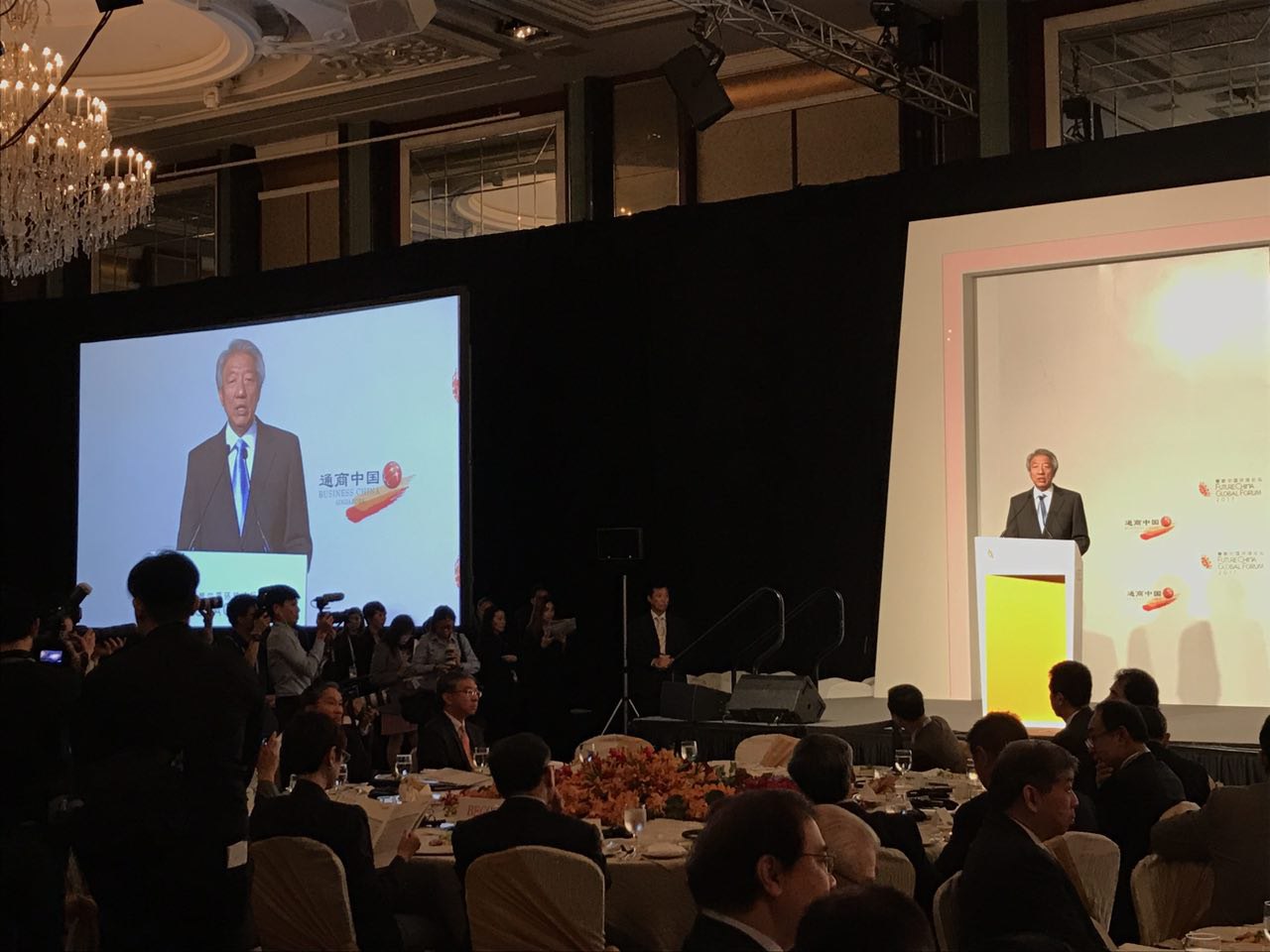DPM Teo outlines 3 key areas where Singapore, China can work together to realise full potential of Belt and Road Initiative
Sign up now: Get ST's newsletters delivered to your inbox

DPM Teo Chee Hean speaking at the FutureChina Global Forum.
ST PHOTO: DANSON CHEONG
Follow topic:
SINGAPORE - Deputy Prime Minister Teo Chee Hean has pledged that Singapore will work with China to help realise the Belt and Road Initiative and outlined broadly three key areas of cooperation.
Calling the initiative a "grand vision", he said it "has the potential to bring long-lasting benefits for regional development and integration, uplifting the economies and people across this whole vast region".
DPM Teo was giving the opening address at the FutureChina Global Forum, and also spoke of ties between Singapore and China, saying both have "built strong bilateral relations that has adapted with the changing needs of both countries over the years".
He noted that when Prime Minister Lee Hsien Loong and Chinese President Xi Jinping met last week in Hamburg, before the Group of 20 Leaders' Summit, they affirmed the substantive relationship between their countries, the frequent high-level exchanges and good progress in bilateral cooperation.
"Our cooperation on the Belt and Road Initiative is a key example of this, which has much potential for broadening and deepening our relationship and taking it to the next level," said DPM Teo.
The initiative is a key area of work for the Singapore-China Joint Council for Bilateral Cooperation, which he co-chairs with Chinese Vice-Premier Zhang Gaoli, he added.
A brainchild of President Xi, the initiative envisions upgrading trade links along the ancient Silk Road economic belt and building a modern maritime Silk Road.
These will link China to countries in Asia, Europe and Africa through a network of roads, ports, bridges, tunnels, pipelines and other projects that involve 68 nations and two-thirds of the world's population.
Attention, however has often focused on the physical infrastructure along the Belt and Road, said DPM Teo. But, he added, "other dimensions and layers are also important to realise (its) full potential".
"These include going beyond individual projects to form a network, beyond physical links to include digital and human networks; leveraging on international and institutional financial resources; and working inclusively with partners all along the Belt and Road."
Singapore will work with China to help realise this potential, he said, highlighting three areas where they could work together to achieve it.
1. Enhancing physical and digital connectivity
The investments in cities and hubs along the Belt and Road can achieve its full potential if these areas "form a network that allows the safe and free flow of goods", said DPM Teo.
This includes passage overland across Central Asia, and on the high seas through the South China Sea, Straits of Malacca and Singapore, as well as the Indian Ocean.
"Singapore is a strong proponent of the right of transit passage for ships and aircraft of all countries through the Straits of Malacca and Singapore. This is a key principle of vital interest to us as trade is our lifeblood," he said.
"Working together to keep the critical sea lanes open and safe for shipping from all countries, and for all countries, is a key pre-requisite for the modern Maritime Silk Road," he added.
Separately, digital technology should also be used to "connect people and enhance the flow of goods, services and data among cities along the Belt and Road".
This would create a network effect that magnifies the benefits of the initiative in both the physical and virtual space, said DPM Teo.
He pointed to the Chongqing Connectivity Initiative (CCI) as an example. This government-to-government project, launched two years ago, aims to drive growth in China's less-developed western region by improving the city's transport and services links to the region and beyond.
2. Enhancing financial cooperation
Financial institutions with major operations in Singapore and service countries along the Belt and Road can also play an active role in financing trade and investments between China and Asean, said DPM Teo.
He noted that emerging economies in Asia will likely need US$26 trillion (S$36 trillion) in infrastructure investment from now till 2030.
There are opportunities to deepen financial links between Singapore and China to support the financing needs of the Initiative and the internationalisation of China's currency.
"Chinese banks in particular, are growing their operations in Singapore to support the needs of Chinese and Singapore-based corporates participating in the Belt and Road," he said.
The Asian Infrastructure Investment Bank (AIIB) can also work with other multilateral financing institutions in Singapore, such as the International Bank for Reconstruction and Development, International Finance Corporation and the Multilateral Investment Guarantee Agency, he added.
The AIIB was initiated by China and Singapore joined 20 other countries as founding signatories of the agreement.
DPM Teo also said that officials from Belt and Road countries need to "raise their knowledge of project preparation and finance, and to operate and sustain" the upcoming projects.
3. Enhancing people-to-people connectivity
Both Singapore and China could undertake joint collaborations with third countries along the Belt and Road to develop their human capital.
"This could include programmes to share experiences in project preparation and finance, operating ports and airports, and managing industrial parks and free trade zones," said DPM Teo.
The experience from the three joint government projects - the CCI, Suzhou Industrial Park and Tianjin Eco-City - would also be useful for Belt and Road projects.
He added that think tanks in both countries could also be encouraged to do joint research and seminars on the Belt and Road.
Said DPM Teo: "Such mutual learning is in line with the Silk Road Spirit of peace and cooperation, openness and inclusiveness, mutual learning and mutual benefit."

